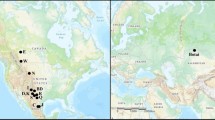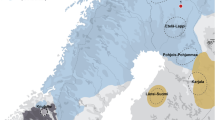Abstract
This research presents age class and gender ratio for 13 horses from burial 15 of the Kalasu cemetery in Habahe County, Aletai Region, Xinjiang, western China. Through the identification of horse age and gender and examination of abnormalities revealed on teeth, vertebrae, and limb bones, the authors analyzed possible strategies practiced by prehistoric society for the selection of horses for burials and also confirmed the evidence of horseback riding shown on skeletal morphologies. By zooarchaeological research at the first time in this area, this research provides important evidence for horse exploitation strategies of nomads in the early Iron Age in northern Xinjiang, China.




























Similar content being viewed by others
References
Anthony DW, Brown DR (2000) Eneolithic horse exploitation in the Eurasian steppes: diet, ritual and riding. Antiquity 74(283):75–86. https://doi.org/10.1017/S0003598X00066163
Anthony DW, Vinogradov NB (1995) Birth of the chariot. Archaeology 48(2):36–41
Barber EW (1999) The mummies of Urumqi. W.W.Norton & Company, New York
Bartosiewicz L (2013) Shuffling nags, lame ducks: the archaeology of animal disease. Oxbow Books, Oxford
Brown D, Anthony D (1998) Bit wear, horseback riding and the Botai site in Kazakstan. J Archaeol Sci 25(4):331–347. https://doi.org/10.1006/jasc.1997.0242
Cheng TK (1960) Archaeology in China: Shang China (Vol. 2). W.Heffer and Sons, Cambridge
China Agriculture Encyclopedia Committee (1996) Herding. In: Chinese agriculture encyclopedia. Agriculture Press, Beijing(In Chinese)
Evans PA, Jack N, Jones S (2007) Aging horses by their teeth. University of Arkansas Cooperative Extension Service (Division of Agriculture), Fayetteville
Gaunitz C, Fages A, Hanghøj K, Albrechtsen A, Khan N, Schubert M, Seguin-Orlando A, Owens IJ, Felkel S, Bignon-Lau O, de Barros Damgaard P, Mittnik A, Mohaseb AF, Davoudi H, Alquraishi S, Alfarhan AH, al-Rasheid KAS, Crubézy E, Benecke N, Olsen S, Brown D, Anthony D, Massy K, Pitulko V, Kasparov A, Brem G, Hofreiter M, Mukhtarova G, Baimukhanov N, Lõugas L, Onar V, Stockhammer PW, Krause J, Boldgiv B, Undrakhbold S, Erdenebaatar D, Lepetz S, Mashkour M, Ludwig A, Wallner B, Merz V, Merz I, Zaibert V, Willerslev E, Librado P, Outram AK, Orlando L (2018) Ancient genomes revisit the ancestry of domestic and Przewalski’s horses. Science 360:111–114. https://doi.org/10.1126/science.aao3297
Hatting T (1995) Sex-related characters in the pelvic bone of domestic sheep (Ovis Aries L.). Archaeofauna. Int J Archaeozoology 4:71–76
Herodotus (2003) The histories. Penguin Books, London
Hou YF, Zhang CN, Ma XL, Zheng WJ (2013) A study on sacrificial animal remains from the Kaihou cemetery in Licheng, Shanxi. Jiang Han Archaeology 4:106–115 (In Chinese)
Jeffcott LB (1979) Back problems in the horse-a look at past, present and future progress. Equine Vet J 11(3):129–136. https://doi.org/10.1111/j.2042-3306.1979.tb01324.x
Jeffcott LB (1980) Disorders of the thoracolumbar spine of the horse:a survey of 443 cases. Equine Vet J 12(4):197–210. https://doi.org/10.1111/j.2042-3306.1980.tb03427.x
Lepetz S (2013) Horse sacrifice in a Pazyryk culture kurgan: the princely tomb of Berel’(Kazakhstan): selection criteria and slaughter procedures. Anthropozoologica 48(2):309–321. https://doi.org/10.5252/az2013n2a9
Levine MA (1982) The use of crown height measurements and eruption-wear sequences to age horse teeth. In: Wilson B, Grigson C, Payne S (eds) Ageing and sexing animal bones from archaeological sites. B.A.R, Oxford, pp 223–250
Levine MA (1999) Botai and the origins of horse domestication. J Anthropol Archaeol 18:29–78. https://doi.org/10.1006/jaar.1998.0332
Levine MA, Whitwell KE, Jeffcott LB (2005) Abnormal thoracic vertebrae and the evolution of horse husbandry. Archaeofauna 14:93–109
Li Y, You Y, Liu YT, Xu N, Wang JX, Ma J, Ren M, Xi TY (2016) Research on abnormal phenomena of horse vertebrae in the Shirenzigou and Xigou site, Xinjiang. Kaogu 1:108–120 (In Chinese)
Linduff KM (2003) A walk on the wild side: late Shang appropriation of horses in China. In: Levine MA, Renfrew C, Boyle K (eds) Prehistoric steppe adaptation and the horse. McDonald Institute for Archaeological Research, Cambridge, pp 139–162
Liu L, Chen XC (2012) The archaeology of China: from the late paleolithic to the early bronze age. Cambridge University Press, New York
Olsen S (2006) Early horse domestication: weighing the evidence. In: Olsen SL, Littauer MA, Rea I (eds) Horses and humans: the evolution of human-equine relationships. Archaeopress, Oxford, pp 81–114
Outram AK et al (2009) The earliest horse harnessing and milking. Science 323(6):1332–1335. https://doi.org/10.1126/science.1168594
Qin LR, Mao HF (1992) Pathological anatomy of domestic animals. China Agriculture Press, Beijing (In Chinese)
Reitz EJ, Wing ES (2013) Zooarchaeology, 2nd edn. Cambridge University Press, New York
Rudenko S (1970) Frozen tombs of Siberia: the Pazyryk burials of Iron Age horsemen. University of California Press, Berkeley and Los Angeles
Taylor WTT (2017) Horse demography and use in bronze age Mongolia. Quat Int 436:270–282. https://doi.org/10.1016/j.quaint.2015.09.085
Taylor WTT et al (2015) Equine cranial morphology and the identification of riding and chariotry in late Bronze Age Mongolia. Antiquity 89:854–871. https://doi.org/10.15184/aqy.2015.76
Townsend HGG, Leach DH, Doige CE, Kirkaldy-Willis WH (1986) Relationship between spinal biomechanics and pathological changes in the equine thoracolumbar spine. Equine Vet J 18:107–112. https://doi.org/10.1111/j.2042-3306.1986.tb03559.x
Veterinary University of the Chinese People’s Liberation Army (1979) Anatomical atlas of the horse. Jilin People Press, Jilin (In Chinese)
Wang JG (2006) Agropastoral ecology and traditional Mongolian societies. Shangdong Renmin Press, Jinan (In Chinese)
Wang MK (2008) Nomads’ choice: facing the northern Asian nomadic tribes in the Han Empire. Guangxi Normal University Press, Nanning (In Chinese)
Warmuth V, Eriksson A, Bower MA, Barker G, Barrett E, Hanks BK, Li S, Lomitashvili D, Ochir-Goryaeva M, Sizonov GV, Soyonov V, Manica A (2012) Reconstructing the origin and spread of horse domestication in the Eurasian steppe. Proc Natl Acad Sci 109(21):8202–8206. https://doi.org/10.1073/pnas.1111122109
You Y, Zhong H, Yu C (2016) The Ethnological investigation and research on the subsistences of the Shirenzigou site in Balikun County, Xinjiang. Cult Relics in South Chin 2:116–122 (In Chinese)
Yu JJ, Hu WL (2015) The excavation of the Kalasu cemetery in Habahe county of Xinjiang in 2014. W Reg Stud 1:131–132 (In Chinese)
Zhou BX (1996) Examination on the animal bones found at the tomb of Zhang Qing of Jin state, Taiyuan. In: Shannxi Institute of Archaeology and Taiyuan Relics Committee (ed) Tomb of Zhang Qing of Jin state, Taiyuan. Wen wu chu ban she, Beijing, pp 248–252 (In Chinese)
Acknowledgments
Doctor Xianglong Chen gave valuable feedback on the earlier drafts. Special thanks to Professor Jing Yuan, Professor Haotian Wang, and Doctor Peng Lü for their contributions on conservation of horse bones of burial 15 in the Kalasu cemetery, to Professor László Bartosiewicz for his suggestions on pathologies and slaughter patterns, and to Tongyuan Xi, Jiajing Wang, Yahui He, Jingbo Li and Qiong Huo for their suggestions on this paper. Last but not least, we want to express our deep gratitude to the two anonymous reviewers for their detailed and constructive comments. This project was sponsored by Chinese National Social Science Fund (16CKG021).
Author information
Authors and Affiliations
Corresponding author
Additional information
Publisher’s note
Springer Nature remains neutral with regard to jurisdictional claims in published maps and institutional affiliations.
Rights and permissions
About this article
Cite this article
You, Y., Yu, J., Betts, A. et al. A zooarchaeological study on the new evidence of sacrificial horses from Iron Age burial 15 in the Kalasu cemetery, Xinjiang, China. Archaeol Anthropol Sci 12, 51 (2020). https://doi.org/10.1007/s12520-019-00980-8
Received:
Accepted:
Published:
DOI: https://doi.org/10.1007/s12520-019-00980-8




